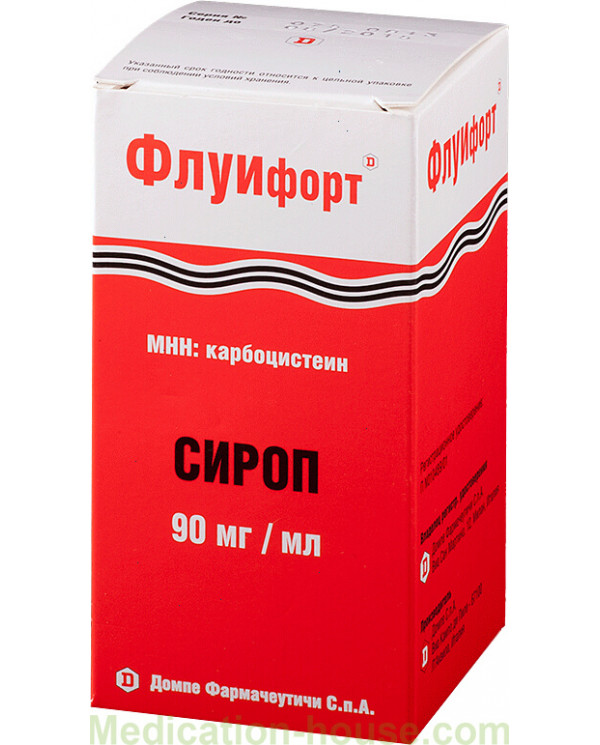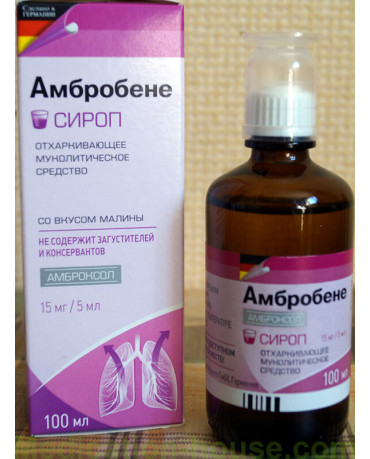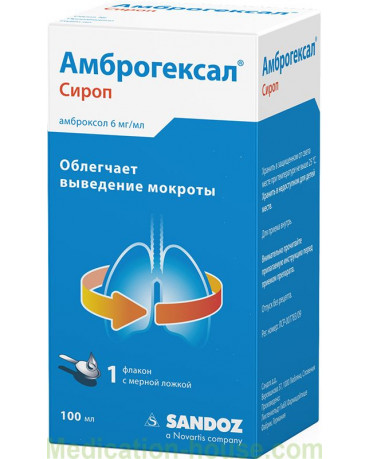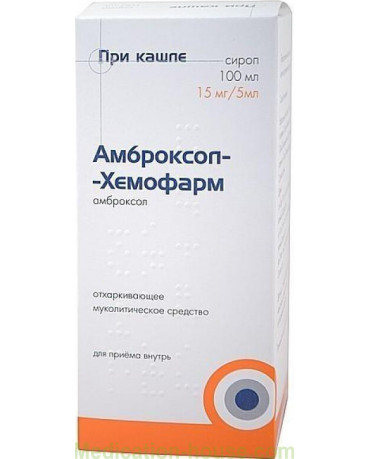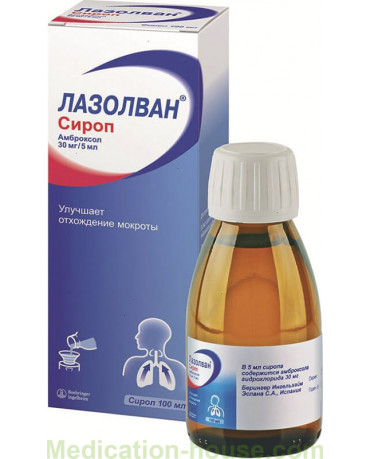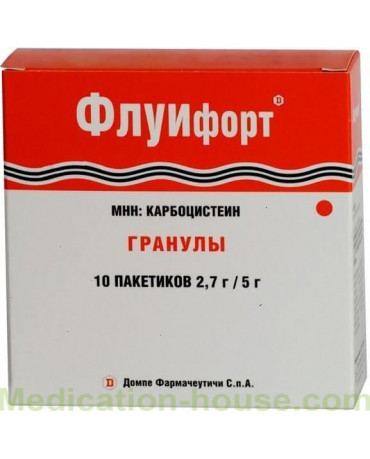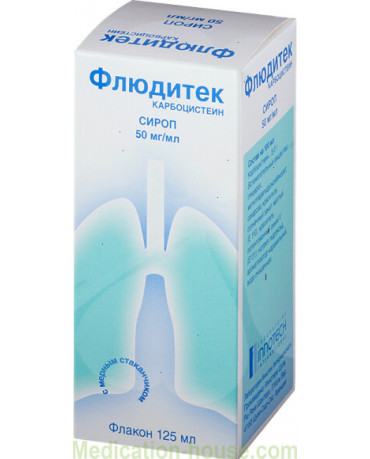Fluifort syrup instruction
You can buy Fluifort syrup here
Composition
100 ml of syrup contains:
Active ingredient: lysine carbocysteine monohydrate (in terms of lysine carbocysteine) 9.0 g.
Excipients: sucrose 40.00 g, cherry flavor 0.25 g, methyl parahydroxybenzoate 0.15 g, caramel 0.03 g, purified water to 100 ml.
Pharmacodynamics
Carbocysteine lysine salt restores the viscosity and elasticity of the mucous secretion of the upper and lower respiratory tract. The effect is dose dependent.
The mucolytic and expectorant effect of lysine salt carbocysteine is due to the activation of sialic transferase (an enzyme of goblet cells of the bronchial mucosa). It normalizes the quantitative ratio of acidic neutral mucins of bronchial secretion: reduces the number of neutral glycopeptides, increases the amount of hydroxyalogenoglycopeptides. Reduces the viscosity of the bronchial secretion and discharge from the sinuses, facilitates the discharge of sputum and mucus, reduces cough. It promotes the regeneration of the mucous membrane, normalizes its structure, reduces the number of goblet cells, especially in the terminal bronchi and, as a result, reduces the production of mucus. Restores the secretion of immunologically active IgA (specific protection), improves mucociliary clearance and antibiotic transport.
In addition, carbocysteine lysine salt stimulates the secretion of chlorine ions in the epithelium of the respiratory tract. This phenomenon is associated with the transport of water and, thus, with the thinning of the mucous secretion. Carbocysteine lysine salt increases the concentration of lactoferrin, lysozyme and α1-antitrypsin, which indicates the functional recovery of mucous cells of the bronchial glands and their mechanism of protein synthesis.
Carbocysteine lysine salt is a neutral compound (pH 6.8), it is soluble in water and therefore does not irritate the gastric mucosa, which allows you to assign a daily dose in one go.
Pharmacokinetics
Quickly and almost completely absorbed after oral administration. The bioavailability of lysine carbocysteine is mild (less than 10% of the dose) and does not depend on the dosage form. The maximum concentration of Cmax in the blood and willows of the mucous membrane is reached after 1.5 - 2 hours. The plasma half-life is 2-3 hours. As all derivatives with a blocked thiolytic group, carbocysteine lysine salt has the highest affinity for bronchopulmonary tissue. Fluifort syrup reaches an average concentration in the mucosa of 3.5 μg / ml with a half-life of about 1.8 hours (2 g daily dose). Complete elimination occurs after 3 days.
Excretion is carried out mainly by the kidneys. Part of Fluifort syrup is excreted by the kidneys unchanged (30 - 60%), the rest is excreted in the form of metabolites.
Indications for use
Acute and chronic bronchopulmonary diseases, accompanied by the formation of viscous and difficult to separate sputum (tracheitis, bronchitis, tracheobronchitis, bronchial asthma, bronchiectasis) and mucus (inflammatory diseases of the middle ear and paranasal sinuses - rhinitis, adenoiditis, otitis media, sinusitis) bronchography.
Contraindications for use
Hypersensitivity to any component of Fluifort syrup. Peptic ulcer of the stomach and duodenum (stage of exacerbation). Pregnancy (I trimester) and the period of breastfeeding. Children's age up to 1 year. The drug should not be taken by patients with hereditary disorders, such as glucose-galactose malabsorption or sucrose-isomaltase deficiency.
Use during pregnancy and breastfeeding
The use of Fluifort syrup is contraindicated in the first trimester of pregnancy and during breastfeeding.
Dosage and administration
Inside. A measuring cup with divisions, according to the recommended doses, is attached to the package.
Children from 1 year to 5 years: 2.5 ml of syrup (225 mg) - 2-3 times a day.
Children over 5 years: 5 ml syrup
(450 mg) - 2-3 times a day.
Adults: 15 ml of syrup (1.35 g) - 2-3 times a day.
The duration of treatment is determined by the doctor (from 4 days to 6 months).
The indicated dosage is maintained for patients with impaired liver and kidney function, as well as for patients with diabetes.
To open the bottle, press the cap on top and turn it counterclockwise. After use, tighten the cap again.
Side effects
The experience gained with the use of Fluifort syrup indicates that adverse reactions occur very rarely (frequency <1/10 000):
Disorders from the skin and subcutaneous tissues: rash, urticaria, erythema, bullous exanthema / erythema, pruritus, angioedema, dermatitis.
Gastrointestinal disorders: abdominal pain, nausea, vomiting, diarrhea.
Disorders of the nervous system: dizziness.
Disorders from the cardiovascular system: hyperemia.
Disorders of the respiratory system: dyspnea.
All these violations are transient in nature and disappear after stopping the drug or after reducing the dosage.If any side effect occurs, you should immediately stop taking Fluifort syrup and consult a doctor.
Overdose
Symptoms: skin reactions, gastrointestinal and sensory system disorders.
Overdose relief measures
There is no specific antidote. Gastric lavage and specific supportive therapy are recommended.
Interaction with other drugs
No interaction of carbocysteine and food, as well as substances used for laboratory research.
The effect is weakened by antitussive and m-anticholinergic drugs.
Increases the effectiveness of glucocorticosteroids (mutually) and antibiotic therapy of infectious and inflammatory diseases of the upper and lower respiratory tract.
Enhances the bronchodilator effect of theophylline.
Special instructions
The use of Fluifort syrup does not lead to addiction or metabolic dependence.
The drug contains methyl parahydroxybenzoate, which can cause hives.
Fluifort syrup does not affect low-calorie and controlled diets, and can also be used in diabetic patients.
Patients with diabetes should be aware that 1 tablespoon of syrup contains 6 g of sucrose.
Impact on the management of vehicles and mechanisms
The drug does not affect the ability to drive vehicles and engage in other potentially dangerous activities that require concentration and speed of psychomotor reactions.
Release form
Syrup 90 mg / ml.
120 ml of syrup in a bottle of dark glass. The bottle is closed with a plastic cap, protected from opening by children.
1 bottle complete with a measuring cup made of polypropylene and instructions for use in a pack of cardboard.
Do not use after the expiration date indicated on the package!
Storage conditions
At a temperature not exceeding 25 ° C.
Keep out of the reach of children!
Shelf life - 2 years.
Terms of sell
You can buy Fluifort syrup without a prescription.

